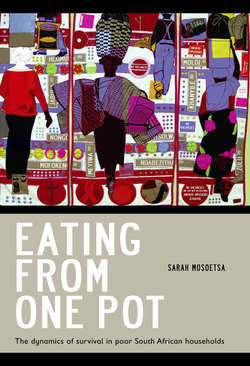Читать книгу Eating from One Pot - Sarah Mosoetsa - Страница 9
На сайте Литреса книга снята с продажи.
Poverty and unemployment in KwaZulu-Natal
ОглавлениеBetween 1990 and 2004, the number of people working in the formal economy in the country declined by almost a million, while the number of those working in the informal economy rose by two million. The majority of the unemployed are located in rural areas and in poor provinces. The provinces with the highest unemployment rate in 2004 were Eastern Cape (32,5 per cent), KwaZulu-Natal (32,2 per cent), Limpopo (30,9 per cent) and North West (30,4 per cent) (StatsSA, 2004).
Poverty in KwaZulu-Natal, home to the two communities that are examined in this book, is increasing. Approximately two million children live in households whose monthly per capita income is less than R350 a month (StatsSA, General Household Survey, 2002-2007). The province also has the biggest HIV and AIDS problem in the country.9
South Africa became a signatory of the Marrakech Agreement, which replaced the General Agreement on Tariffs and Trade (GATT), in 1994. This marked the beginning of a new phase of accelerated trade liberalisation in the country, in accordance with the ‘shock treatment’ economic principles recommended by the World Trade Organisation (WTO). Manufacturing underwent radical changes as South Africa pursued trade liberalisation and implemented macro-economic policies that were intended to enable it to compete internationally and to position itself on the ‘high road’ – a route that emphasises high skills through training and high wages through effective collective bargaining, rewards and incentive schemes. Trade liberalisation entailed a shift away from the country’s previous import substitution industrialisation policies. This had a devastating effect on the manufacturing sector in KwaZulu-Natal.10 Retrenchments, relocations, and factory closures became a regular feature of neo-liberal, post-apartheid KwaZulu-Natal. By 1998, it was estimated that 23 per cent of manufacturing jobs in Durban had been lost (Sitas, 2002). The two dominant manufacturing sectors of the province’s economy – clothing and textiles, and footwear – were badly affected. There were massive job losses as factories tried to compete with imports coming from China and Taiwan. The two sectors experienced a 6,3 per cent and 43 per cent decline in employment respectively, between 1992 and 2002. Employment in the footwear industry declined from 27 882 in 1995 to a mere 12 035 in 2002. Production and wages also declined in both sectors in the same period (see Table 1.4.). This trend was accompanied by the growing informalisation of work in the clothing and textile industry and the use of subcontracted labour in order to deliberately evade labour legislation (Fakude, 2000; Skinner & Valodia, 2002). While there has been little export growth in either sector, imports have increased dramatically. Footwear imports increased from 13 per cent in 1992 to 47 per cent in 2002; textile imports increased from 23 per cent to 31 per cent in the same period.
TABLE 1.4 Output, employment and wages in the textile and footwear sectors in South Africa, 1993-2002
Source: Bezuidenhout, Mosoetsa & Roberts (2004).
Notes: Data for 1993 to 1997 are year averages while the data for 1998 to 2001 reflect figures from June of each year. The former homelands were only included from 1996, hence the break shown in the series. Output is in constant 1995 rand millions. Output: labour is rand thousands, constant 1995 prices. Capital: labour (K/L) ratio is total fxed assets per employee in rand thousands for 2002.
The decline of the region’s two major industries has had a devastating effect on the livelihoods of the households in the two townships that are studied in this book, Enhlalakahle near Greytown and Mpumalanga outside Hammarsdale. Enhlalakahle has always been reliant on the footwear sector for employment while people in Mpumalanga have been directly affected by the decline in employment in the textile industry.
